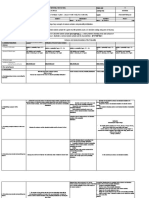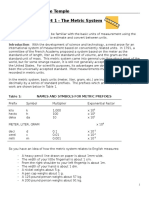0 ratings0% found this document useful (0 votes)
125 viewsIllustrating A Probability Distribution For A Discrete Random Variable and Its Properties
1. The document discusses illustrating a probability distribution for a discrete random variable and its properties.
2. It provides an example of determining the probability distribution of the random variable X, which represents the number of defective computers when testing 3 computers randomly.
3. The possible values of X are 0, 1, 2, and 3, with their respective probabilities determined by the number of outcomes in the sample space that satisfy each value.
Uploaded by
AJ ManialungCopyright
© © All Rights Reserved
Available Formats
Download as PPTX, PDF, TXT or read online on Scribd
0 ratings0% found this document useful (0 votes)
125 viewsIllustrating A Probability Distribution For A Discrete Random Variable and Its Properties
1. The document discusses illustrating a probability distribution for a discrete random variable and its properties.
2. It provides an example of determining the probability distribution of the random variable X, which represents the number of defective computers when testing 3 computers randomly.
3. The possible values of X are 0, 1, 2, and 3, with their respective probabilities determined by the number of outcomes in the sample space that satisfy each value.
Uploaded by
AJ ManialungCopyright
© © All Rights Reserved
Available Formats
Download as PPTX, PDF, TXT or read online on Scribd
You are on page 1/ 5
Illustrating a Probability
Distribution for a Discrete
Random Variable and its
Properties
Statistics and Probability
Statement True False
1. There are 4 outcomes if you tossed two coins. /
2. If you tossed three coins where X be the
What’s In random variable representing the number of tails
that occur. The possible values of the random
A. Determine variable X are 0, 1 and 2.
/
whether the 3. The sum of
statement is TRUE 4. The sum of 0.25 + .06 + 0.36 + 0.28= 0.95 /
or FALSE. If the 5. If , the value of P(1) is /
answer is false, you 6. If , the value of P(4) is /
can modify the /
statement to make
it true.
Steps Solution
1. Determine the sample space. Let
R represent the red ball and G
Find the values of the represent the green ball. S={RR, RG, GR, GG}
random variable Y
representing the
number of green balls
when 2 balls are drawn
2. Count the number of green balls in
in succession without each outcome in the sample space
Possible Outcome Value of the Random Variable
Y (No. of Green Balls)
replacement from a jar and assign the number to this RR
0
outcome.
containing 4 red balls RG
and 5 green balls. 1
GR
1
GG
2
Steps Solution
What’s New 1. Let D represent the defective
computer and N for the non-
Number of Defective Computers
In a computer laboratory, the
defective computer. S= {NND, NDN, DNN, DND,
teacher wants to find out if there is a NDD, DDD,NNN}
defective computer. Supposed
three computers were tested at
random, she asks one of her
Computer System Servicing student
to list all the possible outcomes, 2. Count the number of defective Possible Outcomes Value of the Random Variable X
(number of defective computers)
such that D represents the defective computers in each outcome in the
computer and N represents the sample space and assign this
NND
1
non-defective computer. Let X be number to the outcome. NDN
1
the random variable for the number DNN
1
of defective computers. Then,
illustrate the probability distribution
DND
2
of the random variable X.
DDN 2
NDD
2
DDD 3
NNN 0
There are 4
possible values of
the random Each of these numbers corresponds to an event in the sample
space S of equally likely outcomes for this experiment. Since the
variable X value of the random variable X represents the number of defective
representing the computers, X=0 to (NNN), X=1 to (NND, NDN, DNN), x=2 to (DND,
number of DDN, NDD) and X=3 to (DDD).
defective If each outcomes is equally likely to occur, then the probability is:
computers. The
possible values that
X can take are 0, 1,
2, and 3.
You might also like
- Random Variables and Probability DistributionsNo ratings yetRandom Variables and Probability Distributions23 pages
- Limits of Exponential, Logarithmic and Trigonometric FunctionsNo ratings yetLimits of Exponential, Logarithmic and Trigonometric Functions5 pages
- Mean and Variance of A Discrete Random VariableNo ratings yetMean and Variance of A Discrete Random Variable21 pages
- Grade 11 - General Mathematics Midterm Examination S.Y. 2020-2021 Name: Mark Louie C. Castillo Grade/Section: 11 HUMSS-7 Date: 3/6/2021 ScoreNo ratings yetGrade 11 - General Mathematics Midterm Examination S.Y. 2020-2021 Name: Mark Louie C. Castillo Grade/Section: 11 HUMSS-7 Date: 3/6/2021 Score4 pages
- Alaminos City National High School Summative Assessment in General MathematicsNo ratings yetAlaminos City National High School Summative Assessment in General Mathematics3 pages
- Pre Calculus TQ 1st Q Examination With Answer KeyNo ratings yetPre Calculus TQ 1st Q Examination With Answer Key4 pages
- Fourth Quarter Periodical Test in Basic CalNo ratings yetFourth Quarter Periodical Test in Basic Cal6 pages
- Daily Lesson Log of Stem - Bc11Lc-Iiic-1 (Week Three-Day One)No ratings yetDaily Lesson Log of Stem - Bc11Lc-Iiic-1 (Week Three-Day One)3 pages
- (Stem - Bc11Lc-Iiia-1) (Stem - Bc11Lc-Iiia-2) (Stem - Bc11Lc-Iiia-3) (Stem - Bc11Lc-Iiia-4)No ratings yet(Stem - Bc11Lc-Iiia-1) (Stem - Bc11Lc-Iiia-2) (Stem - Bc11Lc-Iiia-3) (Stem - Bc11Lc-Iiia-4)6 pages
- Day 5 - Limit Definition of The DerivativeNo ratings yetDay 5 - Limit Definition of The Derivative28 pages
- Daily Lesson Log of Stem - Bc11Lc-Iiib-2: 1. Explain How The Answer Was Arrived at 2. 3. 4No ratings yetDaily Lesson Log of Stem - Bc11Lc-Iiib-2: 1. Explain How The Answer Was Arrived at 2. 3. 42 pages
- Third Quarter Examination in Basic Calculus100% (1)Third Quarter Examination in Basic Calculus4 pages
- Learning Activity Sheets-Pre Cal - (Week 1)No ratings yetLearning Activity Sheets-Pre Cal - (Week 1)2 pages
- Basic Calculus: Learning Activity Sheet Limits Background Information For LearnersNo ratings yetBasic Calculus: Learning Activity Sheet Limits Background Information For Learners15 pages
- Daily Lesson Log of Stem - Bc11Lc-Iiib-2: Compare The Graph of The Three Special FunctionsNo ratings yetDaily Lesson Log of Stem - Bc11Lc-Iiib-2: Compare The Graph of The Three Special Functions5 pages
- GenMath Q1 W9 Logarithmic-Functions-and-their-Graphs Elegado Bgo100% (1)GenMath Q1 W9 Logarithmic-Functions-and-their-Graphs Elegado Bgo29 pages
- Activity #10 - DIFFERENT TYPES OF HYPOTHESIS TESTINGNo ratings yetActivity #10 - DIFFERENT TYPES OF HYPOTHESIS TESTING3 pages
- Representing Real Life Situations Using FunctionsNo ratings yetRepresenting Real Life Situations Using Functions20 pages
- Prelim Examination in Statistics and Probability - Grade 11No ratings yetPrelim Examination in Statistics and Probability - Grade 113 pages
- Computing Probability Corresponding To A Given Random VariableNo ratings yetComputing Probability Corresponding To A Given Random Variable6 pages
- Solving Problems Involving Mean and Variance of Probability DistributionNo ratings yetSolving Problems Involving Mean and Variance of Probability Distribution12 pages
- A Set of Numerical Values Assigned To A Sample Space Is CalledNo ratings yetA Set of Numerical Values Assigned To A Sample Space Is Called19 pages
- Scanning Electron Microscope: SEM Images of Tungsten Oxide Nanowires (Left) and Islands (Right)No ratings yetScanning Electron Microscope: SEM Images of Tungsten Oxide Nanowires (Left) and Islands (Right)29 pages
- Ms. Fairbanks - Delta House English III: Reference Sheet of Commonly Used FCAT TermsNo ratings yetMs. Fairbanks - Delta House English III: Reference Sheet of Commonly Used FCAT Terms3 pages
- Omelchenko Oksana & Khankeldiev Sanjar Homework #2: CommentsNo ratings yetOmelchenko Oksana & Khankeldiev Sanjar Homework #2: Comments9 pages
- Kruskal Wallis H Test and Friedman F TestNo ratings yetKruskal Wallis H Test and Friedman F Test16 pages
- How To Write A Concept Paper With Practical Sample by DR LangoNo ratings yetHow To Write A Concept Paper With Practical Sample by DR Lango10 pages
- The Metric System and Scientific Method AnsweredNo ratings yetThe Metric System and Scientific Method Answered11 pages
- Process-Tracing Methods Foundations and PDFNo ratings yetProcess-Tracing Methods Foundations and PDF208 pages
- Brown (2010) Emphasized The Importance of Retaining TeachersNo ratings yetBrown (2010) Emphasized The Importance of Retaining Teachers3 pages
- JBI Critical Appraisal-Checklist For Cohort Studies2017 0No ratings yetJBI Critical Appraisal-Checklist For Cohort Studies2017 07 pages
- Graded Assignment-1 Chemistry (Grade 7) Scientific Enquiry: February 6No ratings yetGraded Assignment-1 Chemistry (Grade 7) Scientific Enquiry: February 64 pages
- 351-Article Text-1362-2-10-20190916 PDFNo ratings yet351-Article Text-1362-2-10-20190916 PDF16 pages
- Biostatistics and Epidemiology Corse Outline 2No ratings yetBiostatistics and Epidemiology Corse Outline 22 pages
- Limits of Exponential, Logarithmic and Trigonometric FunctionsLimits of Exponential, Logarithmic and Trigonometric Functions
- Grade 11 - General Mathematics Midterm Examination S.Y. 2020-2021 Name: Mark Louie C. Castillo Grade/Section: 11 HUMSS-7 Date: 3/6/2021 ScoreGrade 11 - General Mathematics Midterm Examination S.Y. 2020-2021 Name: Mark Louie C. Castillo Grade/Section: 11 HUMSS-7 Date: 3/6/2021 Score
- Alaminos City National High School Summative Assessment in General MathematicsAlaminos City National High School Summative Assessment in General Mathematics
- Daily Lesson Log of Stem - Bc11Lc-Iiic-1 (Week Three-Day One)Daily Lesson Log of Stem - Bc11Lc-Iiic-1 (Week Three-Day One)
- (Stem - Bc11Lc-Iiia-1) (Stem - Bc11Lc-Iiia-2) (Stem - Bc11Lc-Iiia-3) (Stem - Bc11Lc-Iiia-4)(Stem - Bc11Lc-Iiia-1) (Stem - Bc11Lc-Iiia-2) (Stem - Bc11Lc-Iiia-3) (Stem - Bc11Lc-Iiia-4)
- Daily Lesson Log of Stem - Bc11Lc-Iiib-2: 1. Explain How The Answer Was Arrived at 2. 3. 4Daily Lesson Log of Stem - Bc11Lc-Iiib-2: 1. Explain How The Answer Was Arrived at 2. 3. 4
- Basic Calculus: Learning Activity Sheet Limits Background Information For LearnersBasic Calculus: Learning Activity Sheet Limits Background Information For Learners
- Daily Lesson Log of Stem - Bc11Lc-Iiib-2: Compare The Graph of The Three Special FunctionsDaily Lesson Log of Stem - Bc11Lc-Iiib-2: Compare The Graph of The Three Special Functions
- GenMath Q1 W9 Logarithmic-Functions-and-their-Graphs Elegado BgoGenMath Q1 W9 Logarithmic-Functions-and-their-Graphs Elegado Bgo
- Activity #10 - DIFFERENT TYPES OF HYPOTHESIS TESTINGActivity #10 - DIFFERENT TYPES OF HYPOTHESIS TESTING
- Prelim Examination in Statistics and Probability - Grade 11Prelim Examination in Statistics and Probability - Grade 11
- Computing Probability Corresponding To A Given Random VariableComputing Probability Corresponding To A Given Random Variable
- Solving Problems Involving Mean and Variance of Probability DistributionSolving Problems Involving Mean and Variance of Probability Distribution
- A Set of Numerical Values Assigned To A Sample Space Is CalledA Set of Numerical Values Assigned To A Sample Space Is Called
- Scanning Electron Microscope: SEM Images of Tungsten Oxide Nanowires (Left) and Islands (Right)Scanning Electron Microscope: SEM Images of Tungsten Oxide Nanowires (Left) and Islands (Right)
- Ms. Fairbanks - Delta House English III: Reference Sheet of Commonly Used FCAT TermsMs. Fairbanks - Delta House English III: Reference Sheet of Commonly Used FCAT Terms
- Omelchenko Oksana & Khankeldiev Sanjar Homework #2: CommentsOmelchenko Oksana & Khankeldiev Sanjar Homework #2: Comments
- How To Write A Concept Paper With Practical Sample by DR LangoHow To Write A Concept Paper With Practical Sample by DR Lango
- Brown (2010) Emphasized The Importance of Retaining TeachersBrown (2010) Emphasized The Importance of Retaining Teachers
- JBI Critical Appraisal-Checklist For Cohort Studies2017 0JBI Critical Appraisal-Checklist For Cohort Studies2017 0
- Graded Assignment-1 Chemistry (Grade 7) Scientific Enquiry: February 6Graded Assignment-1 Chemistry (Grade 7) Scientific Enquiry: February 6

































































































